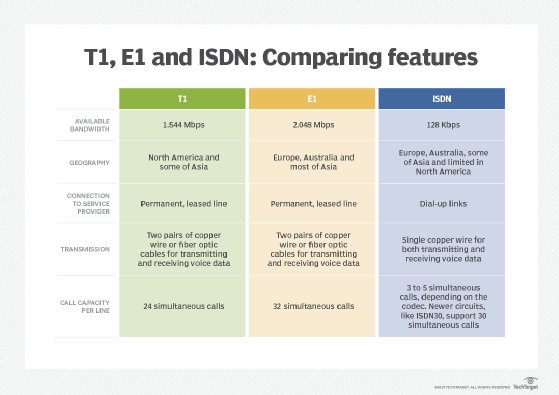
Silvano Rebai - Fotolia
E1 and T1 vs. ISDN: What are the differences?
T1, E1 and ISDN network technology have been used to transmit voice data for years. Compare the similarities and differences between E1 and T1 vs. ISDN links.
In the days before internet connections became ubiquitous, T1, E1 and Integrated Services Digital Network were your WAN link options. They all provided highly reliable service and, even in the age of the internet, many companies still run these dedicated lines. Let's explore the similarities and differences of E1 and T1 vs. ISDN when transmitting voice, video and data.
How do T1 and E1 lines work?
T1 was defined by AT&T in 1962 and is a dedicated line rated for 1.544 Mbps. It consists of 24 channels of 56 Kbps and can transmit up to 24 public switched telephone network voice calls over a single line simultaneously. If you're quick to your calculator, you'll see this does not equal 1.544 Mbps. Each channel has 8 Kbps set aside for signaling, so the allocated bandwidth is 64 Kbps, but only 56 Kbps is usable for data.
Each of these data channels is designated a Digital Signal 0 (DS0), or a transmission rate of 64 Kbps. One or more channels could be bundled for a leased-line customer, which is referred to as fractional T1, or a customer could use and pay for the full T1 bandwidth. T1 is used most widely in North America.
E1 is the European variant of T1. It was defined by the European Conference of Postal and Telecommunications Administrations and provides for a link speed of 2.048 Mbps. This enables each user channel to have 64 Kbps of usable bandwidth. E1 links can simultaneously carry 32 voice calls. Its use and applications outside the U.S. mirror the use of T1 within North America.
What are the differences between T1 and E1 lines?
For all practical purposes, T1 and E1 are the same, but with different speeds. Both are based on time-division multiplexing where time slots are assigned and used to transmit bits for each of the channels in turn.
Both T1 and E1 lines carry DS1 signals and can interconnect with each other globally. T1 and E1 started out carrying voice communications, but now also carry data traffic. Both technologies were extended over the years to higher rates. T3 circuits, for example, provide similar services as T1 but at a 45 Mbps data rate.
What is ISDN and how is it different from T1 and E1?
T1 and E1 are permanent, leased-line services, where ISDN links are dial-up links. T1 and E1 lines are provisioned by a service provider to establish a permanent leased line between two locations. These are static connections and the initial provisioning could take days or weeks. With ISDN, the user can connect through dial-up with other ISDN users, which offers more flexibility.
ISDN's maximum bandwidth of 128 Kbps is significantly lower than T1 and E1, requiring more time to complete bulk tasks, such as file transfer or database backups. ISDN is a metered service, so more time equates to higher costs.

ISDN arrived on the scene much later than T1 and E1 services and will likely be gone sooner. Since its inception in 1988, just about every year of the 1990s was predicted to be The Year of ISDN. But in the U.S., that year never came. Interest in ISDN was much greater outside the U.S.
In 2015, British Telecom announced it would shut down its entire ISDN network in 2025. When ISDN networks are all shut down, we will still likely have T1 and E1.
Since the development of T1, E1 and ISDN, other digital networking technology, such as Carrier Ethernet and software-defined WAN, have emerged to offer additional bandwidth and greater speeds for transmitting voice, data and video.
While the data rates of T1 and E1 lines are considerably slower than even consumer internet connections, they do offer reliable -- if pricey -- service that is typically more stable and secure than common internet connections.







